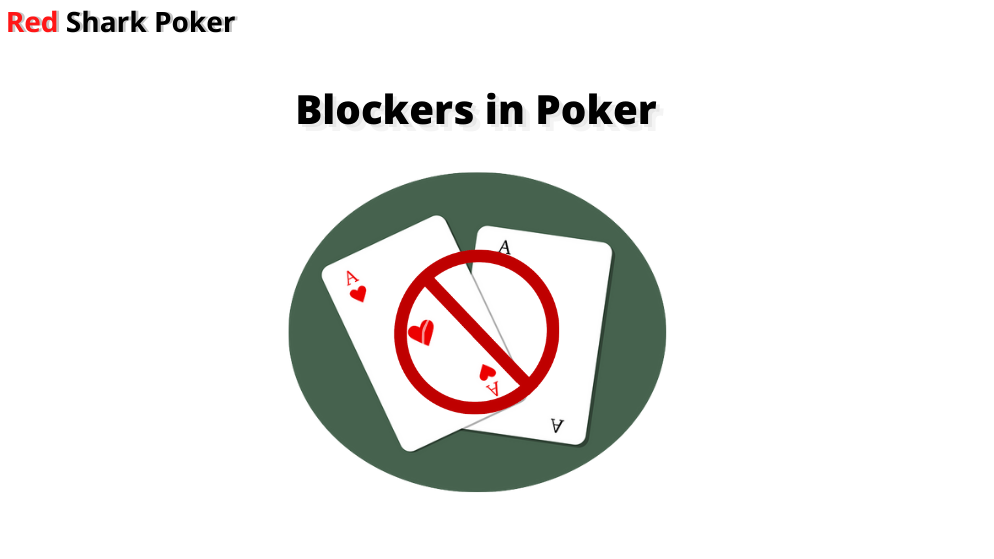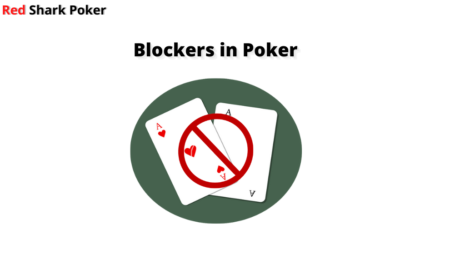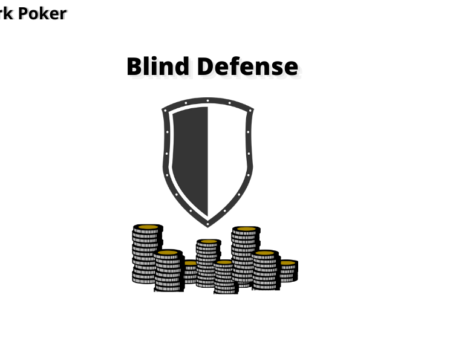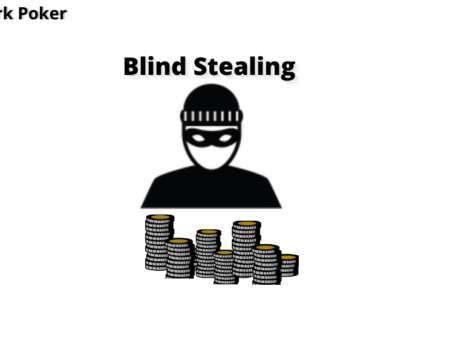

Your hand and the cards on the board can reveal some information about your opponent’s hand. These cards can’t exactly reveal what cards your opponent has, but they can somewhat reveal what cards your opponent doesn’t have. For example, if you hold K♥ K♦ on a K♠ 5♣ 9♥ flop, it is less likely for your opponent to hold a King as you already have 2 Kings and the board has 1 King. Your pocket Kings have blocked your opponent from having a King. Such cards (your hand + board) that block your opponent from holding certain hands are called blockers in poker.
The concept of blockers in poker is best understood with combinatorics or hand combinations. If you don’t know what hand combinations are, we suggest you read this: Poker Hand Combinations Explained
In another example, if you hold AK, it is less likely that your opponent holds AA. There are four Aces in a deck; so, there can be 6 possible combinations of forming pocket aces.
6 Combinations of Aces: A♥A♦, A♠A♣, A♥A♠, A♥A♣, A♦A♠ and A♦A♣
When you hold AK, you have reduced the combinations of your opponent holding pocket aces. As you already hold an Ace, there are 3 Aces available in the deck. So, there are now 3 possible combinations of AA that your opponent can likely hold. In other words, the Ace in your hand has blocked and reduced your opponent’s AA combinations to half. This is also called the removal effect.
A Detailed Example of Poker Blockers
We have a good read on a tight-aggressive opponent. We know that he 4-bets with only AA, KK, QQ and AK.
Perceived Hand Combinations
- AA – 6 combinations
- KK – 6 combinations
- QQ – 6 combinations
- AK – 16 combinations
Total Combinations = 34
Your Hand: KQ
As we have a King and a Queen, we need to apply the card removal effects to find the actual combos of the opponent’s range.
Actual Hand Combinations
AA – 6 combinations
KK – 3 combinations
QQ – 3 combinations
AK – 12 combinations
Total Combinations = 24
We see that total hand combinations due to poker blockers are 24, which is 29.4% less than the perceived hand combinations.
Types of Blockers in Poker
There are 5 common types of blockers that you can use depending on different situations.
Top Set Blocks a Top Pair
If you have a top set on a board, you block the top pair for your opponent. For example,
Your Hand: J♥ J♦
Board: J♣ 5♠ 8♥
Here there is only 1 Jack left in the deck that can form another Jack pair. It is very unlikely that your opponent will be holding a Jack. So, your top set has blocked the top pair on the flop.
Big Cards Block Big Pairs
If you have AK and your opponent 3-bets, it decreases the possibility for your opponent to hold AA or KK. The total hand combo of AA and KK is 12. As you have an Ace and a King, you have blocked and reduced your opponent’s combos of AA and KK to 6. In other words, your big cards AK has blocked the big pairs of AA and KK.
Two Pairs Block Sets
If you have two pairs, you reduce the combos of your opponent’s set. For example,
Your Hand: Q♥ 8♦
Board: Q♣ 5♠ 8♥
Here you have the top two pairs – QQ and 88. Your opponent needs to hold QQ, 88 or 55 to have a set on the flop. So, the possible number of combinations for a set is 9. Since you already hold a Q♥ and an 8♦, you have blocked 4 of the 9 combinations (Q♥ Q♣ and 8♦ 8♥).
Pocket Pairs Block Straights
Let’s understand this poker blocker with an example.
Your Hand: J♥ J♦
Board: 10♣ 9♠ 8♥ 3♦ 2♣
In order to have a nut straight, your opponent needs to have a Jack in his hand. Since you already have pocket Jacks, there are only 2 Jacks left in the deck. If your opponent makes a bet on the river, it is most likely to be a bluff.
You can also use pocket pairs to bluff as a straight. For example,
Your Hand: J♥ J♦
Board: 10♣ 9♠ 8♥ A♦ 2♣
As you have pocket Jacks, it is unlikely for your opponent to hold a Jack. You can use this information and bluff to represent JT or JQ. If your opponent holds the top pair, it will be difficult for him to call as you are strongly representing the nut straight with a big bet.
Big Flush Cards Block Flushes
Let’s understand this poker blocker with an example:
Your Hand: A♥ 10♠
Board: K♥ J♥ 2♣ 5♥
If a tight-aggressive player bets on the turn to represent a flush, you will have to be a little sceptical. There are three big flush cards you know of – A♥ K♥ J♥. As you hold A♥, your opponent cannot hold the nut flush. You need to ask the following questions:
- Does he play with suited gappers like Q♥ 10♥?
- Does he play with widely gapped suited cards like Q♥ 7♥, Q♥ 2♥, etc.?
- Does he play with suited connectors like 6♥ 7♥ or 8♥ 9♥?
If you think that his range does not include these hands, you can raise here to represent the nut flush and force him to fold.
How to Use Blockers in Poker?
Poker blockers are commonly used for bluffing and bluff-catching. Let us learn how to use blockers in both situations.
Use Blockers to Bluff-catch
Your opponent can be value betting or bluffing. A hand that beats your opponent’s bluffs in his range but loses to his value hands is called a bluff-catcher. The act of calling your opponent’s bet with a bluff-catcher is called bluff-catching. Let’s look at an example to understand better:
$5/$10 6 Max Game
You open to $25 from the cutoff with 10♥ 7♥, and the button calls. Everyone else folds.
Flop: 10♠ 2♦ 3♣
You bet $30 with the top pair and your opponent calls.
Turn: 10♠ 2♦ 3♣ 6♥
You bet $50 with the top pair and flush draw, and your opponent calls.
River: 10♠ 2♦ 3♣ 6♥ 9♠
You miss your flush draw but have the top pair. You bet $75, but your opponent raises to $200. The board is wet for a nut straight draw.
You have a bluff-catcher here: your top pair can beat the bluff of your opponent. But you will lose if he is value betting on a strong hand.
Let us analyse this situation with the help of blockers.
Hands that Beat Your Top Pair
Top Pair with a Better Kicker: If your opponent has a top pair with a better kicker (AT, KT, QT or JT), he can beat your hand. As you have a 10, it is unlikely that your opponent has the top pair.
Nut Straight: If your opponent has a 78, he has a straight. As you have a 7, it is unlikely that your opponent could be holding one.
Top Two Pairs: If your opponent has T9, he has the top two pairs. As you have a 10, it is unlikely that your opponent has a 10.
As your hand blocks most of your opponent’s value hands, you can bluff-catch with the help of blockers.
Use Blockers to Bluff
Blockers give you great insights into what cards your opponent is less likely to hold. When you see that your opponent has less or almost zero chances of holding a particular hand, you can choose to bluff by using your blockers in poker. Let’s look at an example:
$5/$10 6 Max Game
You raise to $20 from the MP with 9♦ 9♣ and a tight-aggressive player in the big blind calls.
Flop: K♦ 5♣ 8♣
Your opponent checks and you check behind.
Turn: K♦ 5♣ 8♣ J♦
Your opponent bets $20 into a $45 pot. You call with the pair of nines.
River: Turn: K♦ 5♣ 8♣ J♦ 10♠
Your opponent bets $40 into a pot of $65.
Has your opponent completed his straight? The only hands that complete a straight are Q9, 97 and AQ. Your opponent, being a tight-aggressive player, would have 3-bet with AQ. Since he just called, he certainly does not have AQ. So, the only hands that complete a straight are Q9 and 97.
Your pocket nines block your opponent from holding a nine. So, your opponent is less likely to hold Q9 or 97. You, on the other hand, have a better chance of representing a straight here. You can bluff here to represent a straight with a raise of $120. Even if your opponent has the top pair, he will most likely fold to your strong raise.
A Word of Caution
Blockers can help to make the right decision in tough spots. However, you shouldn’t overestimate and rely completely on them. Blockers suggest cards that your opponent is less likely to have, not impossible to have. You may never know how randomly the cards are dealt. So, don’t make your decisions completely based on blockers in poker. Be critical of your opponent’s ranges and see how his range interacts with the board. Unless you have the nut flush blocker, you can be certain that your opponent doesn’t have the specific suited Ace.
Conclusion
The knowledge and application of blockers will improve your game immensely. By analysing hand combinations, blockers will reduce the total combinations of your opponent’s range. In tough spots, blockers give you great insights into what cards your opponent is less likely to hold. It can help you to bluff or bluff-catch and win pots. Add the application of blockers as a weapon to your arsenal and take down big pots. Good Luck!




